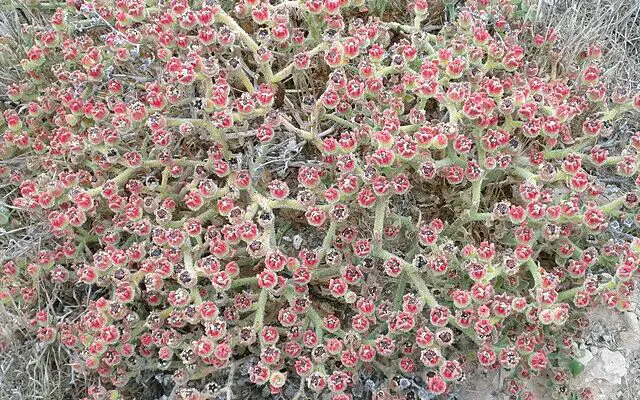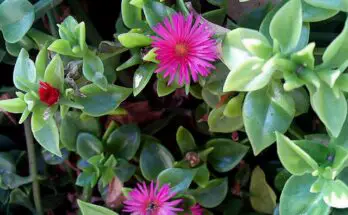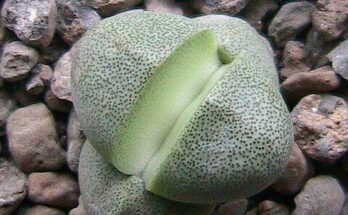Mesembryanthemum, often celebrated for its vibrant flowers and diverse species, is a genus that has captivated gardeners and succulent enthusiasts worldwide. This comprehensive guide delves into the intricacies of Mesembryanthemum care, exploring the plant’s unique characteristics, ideal growing conditions, and effective maintenance strategies.
Origin and Characteristics
Native to South Africa, Mesembryanthemum, also known as the ‘Ice Plant’, is renowned for its dazzling daisy-like flowers and fleshy leaves. This genus encompasses a variety of species, each with distinct features. Some species exhibit a crystalline texture, hence the nickname ‘Ice Plant’, while others are known for their carpet-forming growth habit.
Types of Mesembryanthemum
Mesembryanthemum crystallinum – The Ice Plant Characterized by its sparkling, ice-like appearance, Mesembryanthemum crystallinum is a favorite among gardeners. This species is known for its large, rounded leaves covered in tiny, glistening bladder cells, which give it a frosted look. The plant produces white or pink flowers that bloom under full sun.
Mesembryanthemum cordifolium – Heartleaf Ice Plant The Heartleaf Ice Plant, with its heart-shaped leaves and vibrant flowers, is a popular ground cover.
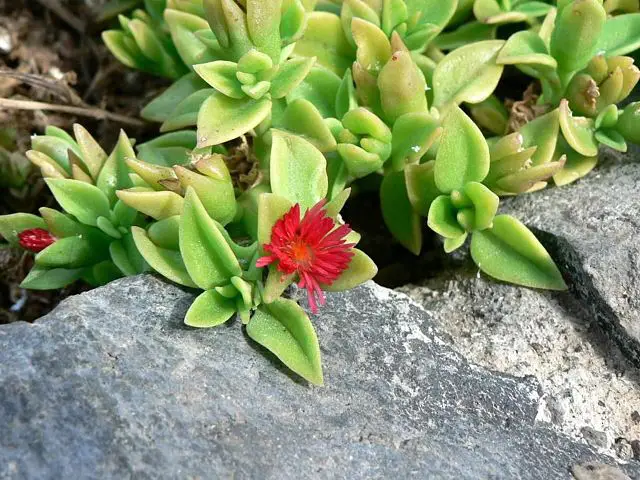
Its leaves are succulent and glossy, creating a lush appearance. This species is known for its daisy-like flowers, which come in shades of pink, purple, and white, blooming profusely in the right conditions.
Mesembryanthemum nodiflorum – Slenderleaf Ice Plant This species is notable for its slender, elongated leaves and compact growth habit. Mesembryanthemum nodiflorum is ideal for rock gardens or as a border plant. It produces small, yellow flowers that add a subtle charm to its overall appearance.

Mesembryanthemum floribundum – Pink Carpet Mesembryanthemum floribundum, aptly named the ‘Pink Carpet’, is known for its dense, mat-forming growth and profusion of pink blooms. This low-growing species creates a stunning carpet of color and is perfect for covering large areas in a garden or cascading over walls.
Caring for Different Types of Mesembryanthemum While each Mesembryanthemum species has its unique features, they share similar care requirements. They prefer well-draining soil, ample sunlight, and infrequent but thorough watering. During the growing season, a balanced fertilizer can promote healthier growth and more vibrant blooms. Regular pruning and deadheading encourage new flowers and maintain the plant’s shape.
Mesembryanthemum Soil and Planting
Creating the ideal environment for Mesembryanthemum starts with understanding the nuances of soil and planting. This succulent thrives in conditions that mimic its native habitat, demanding attention to soil composition and the choice of container, which are pivotal for its healthy growth.
Mesembryanthemum Perfect Soil Mix
The journey begins with the soil, the foundation of any plant’s life. For Mesembryanthemum, a standard cactus mix forms a good base, but the magic lies in customizing this mix. By integrating sand or perlite into the mix, you enhance its drainage capabilities. This modification is more than just mixing components; it’s about creating a breathable, light environment for the roots. The ideal ratio, leaning towards a 2:1 soil to sand or perlite blend, ensures the roots have the perfect balance of moisture and air. Additionally, keeping the soil’s pH slightly acidic to neutral, around 6.0 to 7.5, aligns with the plant’s natural preference.
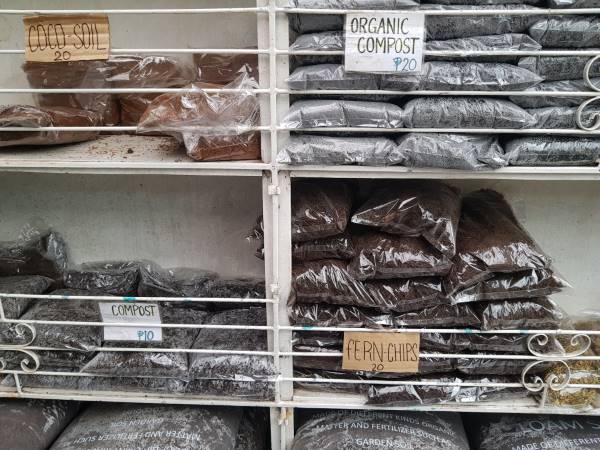
Mesembryanthemum Planting Conteiner
When it comes to housing your Mesembryanthemum, think beyond just a pot – consider it the plant’s universe. A shallow, wide container is ideal, reflecting the natural spreading of the plant’s roots. The choice of material also plays a role; terracotta or ceramic pots are preferable for their porous nature, promoting evaporation and preventing waterlogged soil. Ensuring the pot has sufficient drainage holes is not just a detail, but a necessity to avoid the dreaded root rot.
Planting with Precision and Care The act of planting Mesembryanthemum is a blend of technique and gentleness. Filling the pot with your prepared soil mix, you create a welcoming bed for the plant. Transferring the plant into this new home requires a delicate touch, ensuring it sits at the same depth as in its previous abode. This moment of transplanting is crucial – it’s where the plant begins its new journey. Post-planting, the succulent’s placement in a bright, sunny spot signifies its return to a natural, sun-kissed environment, although a brief period away from harsh sunlight helps it acclimate without stress.
Watering: A Balanced Approach Watering these plants is less about sticking to a schedule and more about understanding their needs. The soil should be allowed to dry completely between waterings, a rhythm that mimics the natural dry periods Mesembryanthemum is accustomed to. This approach encourages the roots to grow stronger as they search for moisture, leading to a more resilient plant.
Light and Temperature
These plants demand plenty of sunlight to flourish. A location receiving at least six hours of direct sunlight is optimal. While Mesembryanthemums are heat-tolerant, they can suffer in extreme temperatures. In scorching climates, afternoon shade is beneficial.
Watering and Feeding
Watering is a critical aspect of Mesembryanthemum care. The ‘soak and dry’ method is effective – water thoroughly when the soil is completely dry, then allow it to dry out again. Over-watering can lead to root rot, a common issue with succulents. During the growing season, a balanced, diluted succulent fertilizer can boost growth and flowering.
Pruning Mesembryanthemum
Pruning plays a critical role in the health and aesthetics of Mesembryanthemum plants. It not only shapes the plant but also stimulates new growth and more prolific flowering.
- Timing for Pruning: The best time to prune is in the late winter or early spring, just as the plant starts to come out of its dormant phase and before the new growth begins.
- Techniques for Pruning:
- Selective Pruning: Remove dead or dying flowers and leaves. This process, known as deadheading, encourages the plant to produce more blooms.
- Shaping the Plant: Trim back overgrown branches to maintain the desired shape. This is particularly important for ground cover varieties to prevent them from overrunning other plants.
- Thinning Out: For denser plants, thin out some stems to improve air circulation, which can help prevent fungal diseases.
- Tools for Pruning: Use sharp, clean pruning shears or scissors. Sterilize your tools before use to prevent the spread of disease.
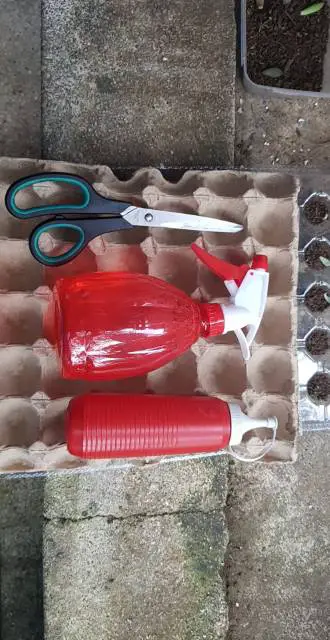
Propagation Techniques for Mesembryanthemum
Propagation allows gardeners to create new plants from an existing plant, which is particularly useful for preserving specific varieties or expanding your garden.
- Propagation through Seeds:
- Collect seeds from a mature Mesembryanthemum after the flowering period.
- Sow the seeds in well-draining soil in a warm, bright location.
- Keep the soil lightly moist until germination, which usually takes a few weeks.
- Leaf Cuttings:
- Choose healthy, plump leaves from the plant.
- Allow the cut end of the leaf to callous over for a day or two.
- Plant the leaf cutting in well-draining soil, ensuring the cut end is buried slightly.
- Water sparingly until roots develop, usually within a few weeks.
- Propagation through Division:
- This method is suitable for mature plants that have formed clumps.
- Carefully uproot the plant and gently separate the clumps into individual plants.
- Replant each division into its pot or a new location in the garden.
Optimal Conditions for Propagation: The ideal time for Mesembryanthemum propagation is in the spring. This season provides a balance of moderate temperatures and increasing daylight, which supports healthy root and shoot development.
Pest and Disease Management
Common pests like aphids and mealybugs can be managed with insecticidal soap or neem oil. Fungal infections, often due to over-watering, can be prevented by ensuring good airflow and proper watering practices.
Mesembryanthemum Winter Care
In colder regions, Mesembryanthemum may require overwintering indoors. Provide bright light and minimize watering, allowing the plant to enter a dormant state.
Mesembryanthemum, with its colorful blooms and resilient nature, is a splendid addition to any succulent collection. By understanding its specific needs and providing the right care, gardeners can enjoy the full beauty and diversity this genus has to offer.
In this article, we explored Mesembryanthemum’s background, ideal growing conditions, and maintenance tips. With this knowledge, gardeners can cultivate these vibrant plants successfully, adding a touch of South African beauty to their gardens or homes.

